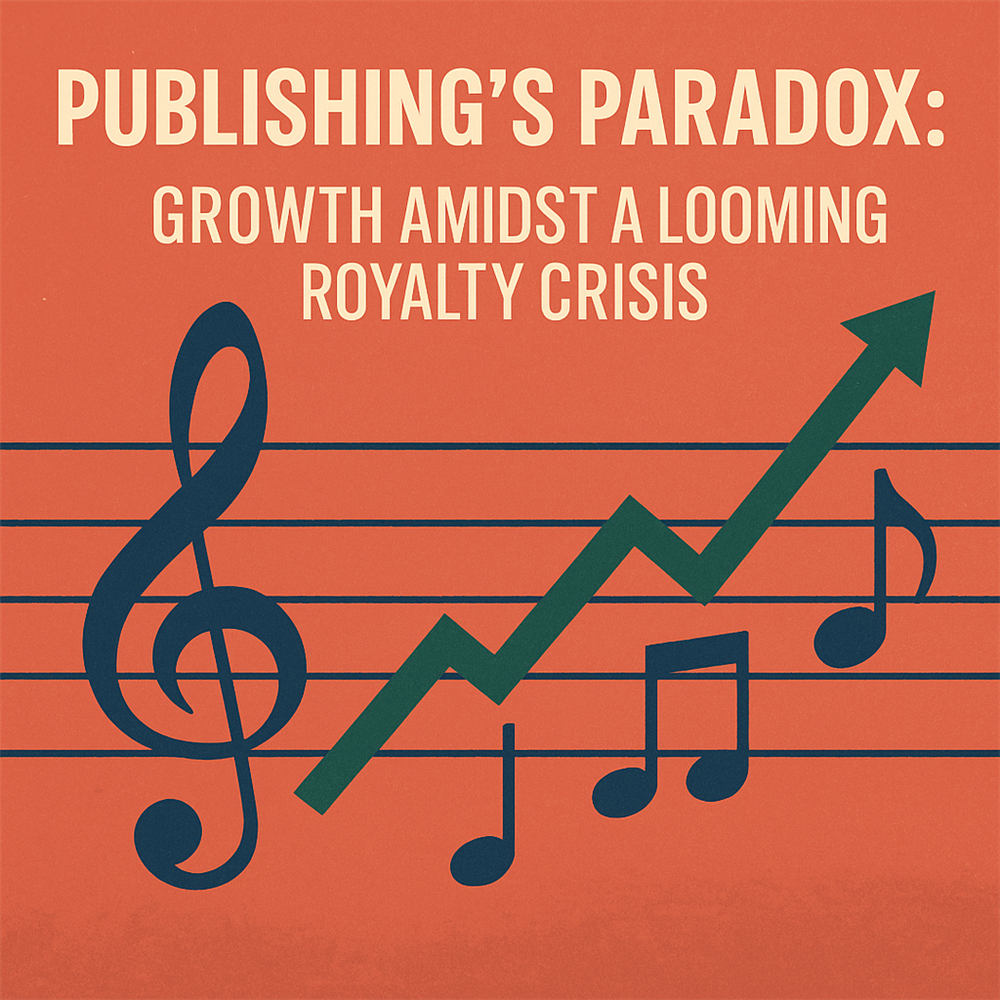In 2024, the U.S. music publishing industry reached a new peak, generating $7.04 billion in revenue, up 13.4% from the previous year. This marked the tenth straight year of double-digit growth, outpacing even the recorded music sector, which grew just 2.7% in the same period.
That success, however, may mask a deeper vulnerability.
While revenue soared, primarily due to improved digital licensing and a historic $2 billion in recovered unpaid royalties, the industry now faces a potentially devastating...
Show All...
In 2024, the U.S. music publishing industry reached a new peak, generating $7.04 billion in revenue, up 13.4% from the previous year. This marked the tenth straight year of double-digit growth, outpacing even the recorded music sector, which grew just 2.7% in the same period.
That success, however, may mask a deeper vulnerability.
While revenue soared, primarily due to improved digital licensing and a historic $2 billion in recovered unpaid royalties, the industry now faces a potentially devastating threat: the manipulation of royalty structures by dominant streaming platforms, most notably Spotify. Through tactics like bundling services, reclassifying offerings, and leveraging regulatory loopholes, these platforms are eroding the very foundations of the publishing business model. And the financial impact could soon eclipse the gains that publishers fought so hard to achieve.
The Nature of the Boom
Music publishing’s rise in recent years has been driven by several compounding trends. In addition to the influx of recovered royalties, the continued expansion of global streaming, sync licensing, and backend collection efforts have helped songwriters and publishers capture more of the value they create. Improved data systems and rights enforcement efforts have been pivotal, especially as platforms become more sophisticated and global in scale.
Digital performance royalties, mechanical royalties from interactive streams, and licensing revenues from user-generated content platforms like TikTok and YouTube have played increasingly important roles in boosting the bottom line. This indicates a healthy, evolving business model, one that is no longer tethered exclusively to physical sales or terrestrial radio.
But even as this infrastructure strengthens, the ground is beginning to shift beneath it.
The Threat Beneath the Surface
In early 2024, Spotify reclassified its Premium subscription plans to qualify as “bundled services” by including audiobook access without lowering subscription prices or clearly notifying consumers. Under current Copyright Royalty Board (CRB) rules, bundled services qualify for a lower mechanical royalty rate. That means Spotify now pays significantly less to publishers and songwriters for the same amount of music consumption.
The National Music Publishers' Association (NMPA) and Mechanical Licensing Collective (MLC) estimate that this strategy alone will result in $230 million in lost revenue for music publishers in 2025. Over the course of the next royalty rate-setting cycle (2028–2032), losses could exceed $3.1 billion.
This isn’t an isolated incident. Amazon Music has followed suit, and there is concern that more platforms could adopt similar models, especially if bundling is seen as a low-risk, high-reward financial maneuver.
The issue isn’t just the money being lost now, it’s the precedent being set. If streaming platforms can redefine what their services are and how they’re categorized without oversight, then mechanical royalty rates, long fought for and hard-won through CRB proceedings, become effectively meaningless. What’s at stake is not just current revenue, but the stability of royalty frameworks that underpin the entire publishing economy.
Manipulating Models, Shifting Costs
This shift in strategy represents a broader trend: the ability of tech platforms to manipulate business models in ways that benefit their own bottom lines while externalizing risk onto rights holders.
Spotify’s bundling maneuver is not a new form of value creation, it’s a reclassification. It allows the company to reduce its royalty obligations without making any meaningful changes to its product or user pricing. While consumers get nominal audiobook access, the core value proposition remains music streaming, yet publishers are being paid as if the value has somehow diminished.
Such tactics point to an increasingly asymmetric power dynamic between platforms and creators. Platforms are setting the terms, often unilaterally, while publishers and songwriters are left to react after the fact through legal complaints, regulatory filings, and lobbying efforts.
The NMPA has filed a complaint with the Federal Trade Commission, arguing that Spotify’s practices are deceptive and anti-competitive. The MLC has sued the company for copyright infringement. U.S. lawmakers are beginning to apply pressure as well, with bipartisan calls for FTC intervention. But the clock is ticking, and every month that passes with bundled pricing in place results in tangible losses for songwriters.
A Fragile Future
The most striking contradiction in today’s music publishing market is that it’s simultaneously the most lucrative it’s ever been and the most at risk.
On paper, the $7 billion in revenue achieved in 2024 paints a picture of a thriving industry. But the structural weakness exposed by Spotify’s bundling strategy reveals how precarious that success may be. If platforms can unilaterally redefine their services, reclassify user tiers, and manipulate royalty formulas without clear checks and balances, then the gains publishers have made over the last decade could be quickly undone.
The publishing industry is no longer just battling for higher rates, it’s fighting to preserve the meaning of rates at all. Without structural reform, a business that has only recently found its footing in the digital age may again be thrust into instability, not due to lack of innovation or value creation, but because of loopholes exploited by the very platforms that rely on songs to survive.
In short, the industry’s biggest challenge ahead may not be growing revenue but stopping its erosion. The outcome of these legal and regulatory fights will determine whether music publishing remains on its current trajectory, or if the boom of the last decade turns out to be a high-water mark before a painful recalibration.
Show Less...